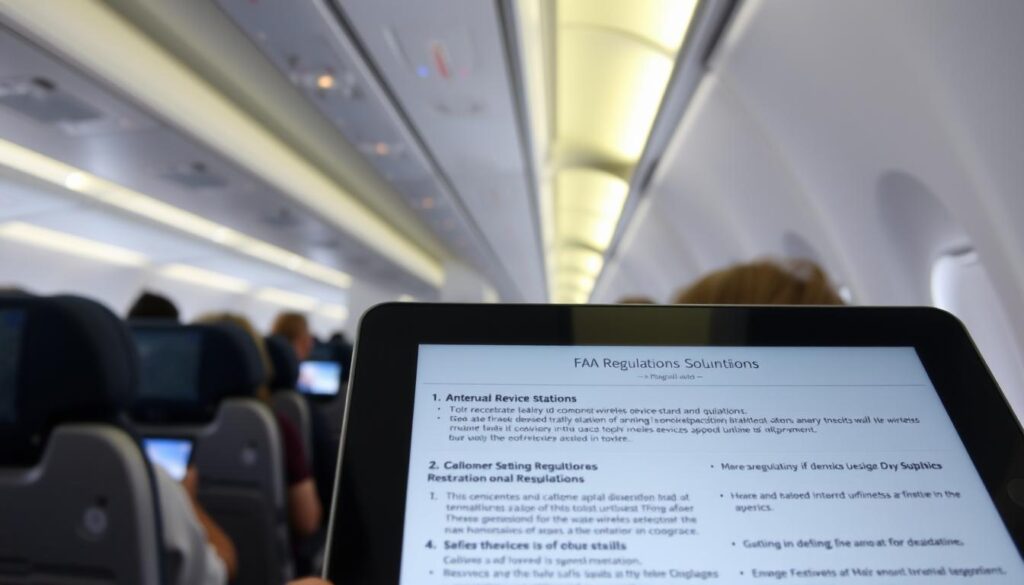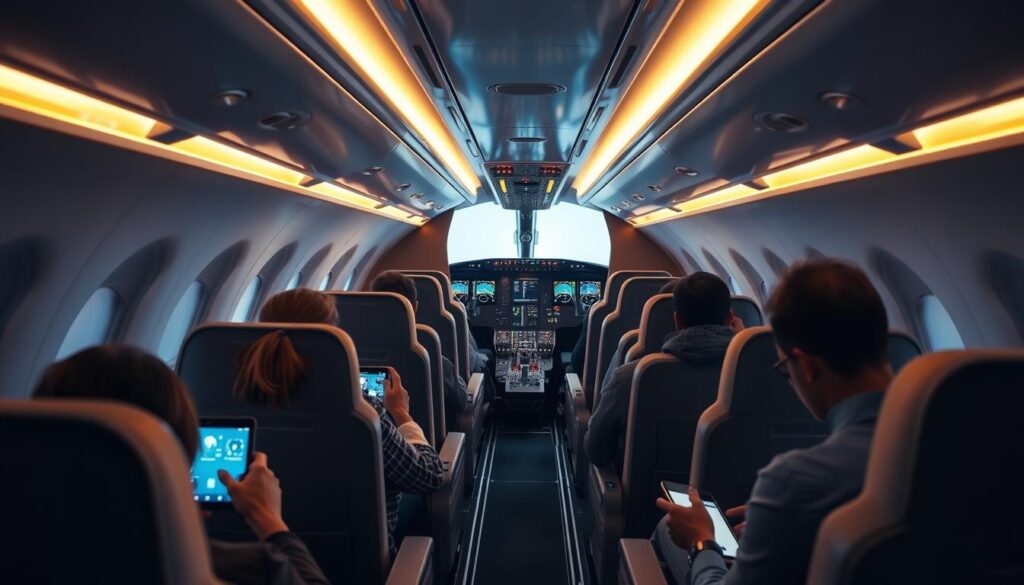Why Airlines Ask You to Switch Off Bluetooth at Takeoff
When flying on commercial carriers, passengers are familiar with the pre-takeoff instructions that require turning off cellular telephones and other portable electronic devices. One of the devices often mentioned is Bluetooth technology.
Bluetooth is a widely used technology that allows devices to communicate with each other over short distances. In the context of air travel, the use of Bluetooth devices has become increasingly common, raising questions about their impact on flight operations.
The requirement to switch off Bluetooth during takeoff is part of airline policies aimed at ensuring safe flight operations. Understanding the reasons behind this policy can provide insights into the complex relationship between in-flight electronics and aircraft systems.
The Safety Protocol Behind In-Flight Electronics Restrictions
Safety protocols surrounding in-flight electronics are crucial for preventing potential disruptions to avionics. Although the likelihood of interference is relatively low with modern aircraft, there is still a potential risk.
Electronic Interference and Avionics
Electronic devices can potentially cause radio interference that disrupts various avionics systems in an aircraft. This interference can impact navigation and communication equipment, posing a risk to airline safety.
To mitigate these risks, airlines implement strict safety protocols. These include restricting the use of electronic devices during critical phases of flight, such as takeoff and landing. Airlines also conduct regular checks on their avionics systems to ensure they are not susceptible to interference.
By understanding and adhering to these safety protocols, passengers play a crucial role in maintaining airline safety. The restrictions on in-flight electronics are a precautionary measure to safeguard against potential risks.
Why Airlines Ask You to Switch Off Bluetooth at Takeoff
When flying, passengers are often asked to turn off their Bluetooth devices, but have you ever wondered why? The primary concern is Bluetooth interference with the aircraft’s communication and navigation systems.
Airlines have specific policies regarding the use of electronic devices during flights. These policies are designed to minimize potential risks. While Bluetooth technology is generally considered safe when used in airplane mode, disabling it during takeoff and landing is a precautionary measure.
The use of electronic devices like smartphones and tablets is widespread, and understanding how they interact with aircraft systems is crucial. Bluetooth signals, although weak, could potentially interfere with the plane’s sensitive equipment.
It’s worth noting that Bluetooth is safe to use on a plane as long as your phone is in airplane mode. Airlines ask passengers to switch off Bluetooth during takeoff as a safety precaution to avoid any potential interference.
The Technical Explanation: How Bluetooth Signals Work
Bluetooth devices operate by sending out periodic bursts of energy, which can be a source of electronic interference. This interference is a concern for airlines because it could potentially disrupt the aircraft’s navigation and communication systems.
Bluetooth technology uses radio waves to communicate between devices. When a Bluetooth device is turned on, it begins to transmit and receive data to and from other Bluetooth-enabled devices.
Bluetooth Signal Transmission
The transmission of Bluetooth signals occurs on a specific frequency band, around 2.4 GHz. This frequency is divided into multiple channels to minimize interference from other devices. However, the periodic nature of Bluetooth signal transmission can still cause issues with sensitive electronics on an aircraft.
Understanding how signal transmission works in Bluetooth devices is crucial for assessing the risk they pose to aircraft systems. While modern aircraft are designed to minimize the impact of such interference, the risk cannot be entirely eliminated.
FAA Regulations and Airline Policies on Wireless Devices
Understanding FAA regulations on wireless devices is crucial for safe air travel. The Federal Aviation Administration (FAA) has specific guidelines that dictate how and when passengers can use wireless devices on airplanes.
In 2013, the FAA updated their guidance on the use of electronic devices during flights, largely due to the prevalence of airplane mode on most cellphones. This change allowed passengers to use their devices in airplane mode during all phases of the flight, including takeoff and landing.

Airline policies have adapted to these regulations, but they can vary between carriers. Most airlines permit the use of wireless devices in airplane mode, but it’s essential for passengers to follow the crew’s instructions regarding device usage during flights.
The FAA continues to monitor the safety of wireless device usage on aircraft. As technology evolves, regulations may change to accommodate new devices and modes of transmission.
Passengers should stay informed about the wireless device policies of their airline to ensure compliance and safe travel.
Bluetooth Devices That Require Special Attention
Some Bluetooth devices require special consideration when flying. While most modern Bluetooth devices are designed to coexist with other electronic systems, certain devices can potentially cause electronic interference.
Devices such as wireless headphones, keyboards, and mice are commonly used Bluetooth devices. However, their use on airplanes can sometimes lead to connectivity issues, not just for the device user but also for people on the ground.
It’s essential for passengers to follow airline instructions regarding the use of Bluetooth devices during flights. This includes switching off devices or putting them in airplane mode when requested. Some devices, like those using Bluetooth 5.0, are designed to be more power-efficient and less likely to cause interference.
Passengers should be aware of the devices they are using and take precautions. For instance, turning off Bluetooth devices when not in use can help minimize potential interference. By being mindful of their device usage, travelers can contribute to a safer and more enjoyable flight experience for everyone on board.
The Future of In-Flight Technology Policies
The aviation industry is at a crossroads, balancing safety with the need for advanced in-flight technology. As airlines continue to upgrade their fleets with newer aircraft, there’s a growing emphasis on integrating modern technologies, including Bluetooth connectivity, into the flying experience.
Advancements in Bluetooth technology are playing a significant role in shaping future policies. Newer Bluetooth versions offer better interference mitigation, potentially reducing the risk of interference with aircraft systems. This development is prompting regulatory bodies like the FAA to reassess their guidelines on the use of Bluetooth devices during flights.

Airlines are also investing in improved in-flight entertainment systems that are more compatible with personal devices, enhancing the passenger experience while maintaining safety standards. The future of in-flight technology policies will likely involve more nuanced rules, potentially allowing for more flexible use of electronic devices during certain phases of flight.
As the industry moves forward, it will be crucial for airlines, regulatory bodies, and technology providers to collaborate closely. This collaboration will ensure that safety remains the top priority while still allowing for the adoption of innovative technologies that can enhance the flying experience.
Conclusion: Balancing Safety and Passenger Convenience
Airlines ask passengers to switch off Bluetooth during takeoff to ensure airline safety. This precaution is taken to prevent potential interference with the aircraft’s navigation systems. While it may seem inconvenient, adhering to this policy is crucial for a safe flight.
Bluetooth technology, like other wireless devices, can potentially disrupt the aircraft’s communication and navigation equipment. By switching off Bluetooth, passengers can help minimize risks and ensure a smooth takeoff.
It’s a matter of balancing airline safety with passenger convenience. As technology advances, airlines and regulatory bodies like the FAA continually update their policies to reflect the changing landscape of wireless devices. Understanding why airlines ask you to switch off Bluetooth at takeoff can help you appreciate the importance of following in-flight electronics restrictions.
So, the next time you’re on a flight and the crew asks you to turn off your Bluetooth, remember that it’s better to be safe than sorry. By following this simple precaution, you’re contributing to a safe and enjoyable flight for everyone on board.
